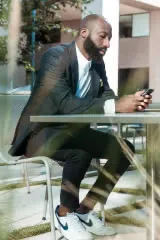Published 18 Jun 2019
Creative Freelancers Bootcamp

April Chung
18 Jun 2019
From illustrators to motion graphics designers, writers and film producers, the Creative Freelancers Bootcamp was open to all in the creative industry who needed an extra hand at finding jobs, or advice on setting their rate cards.
Jointly-organised by Singapore Workforce Development Agency (WDA), NTUC’s U Creative, the Employment and Employability Institute (e2i), METHODOLOGY and Design Sojourn, the full-day event held in Singapore last June 2016 featured seasoned professionals including Black Design’s Patrick Gan, Machinest’s Fizah Rahim, Mindflyer’s Michael Ng and TBWA \ Group Singapore’s Rukshan Perera, who each shared their insights on thriving in the local freelance creative market.
Workshop 1 – Freelancer Basics: Contracts & Invoices
Speaker: Patrick Gan, Black Design

The crowd murmured in agreement when the emcee highlighted that one of the biggest thoughts on a freelancer’s mind is how to charge their clients without making a loss.
First to take the stage was Patrick Gan, an award-winning entrepreneur and co-founder of creative agency Black Design. Drawing lessons from his time in the design and advertising industries, he shared with the eager crowd tips on achieving wealth through freelancing, and also shared advice on how they can eventually craft a business out of their service offerings.
From Freelancer to Creative Entrepreneur
1. Have a niche that will fulfill a need

“We wanted to fulfill that niche because in Singapore, there was no one who could curate cultural museums.”
One thing creatives have to figure out before going freelance is discovering what their innate talent is. As Patrick points out, no graphic designer can just waltz into the creative industry and announce that he wants to make a ton of money. On what basis? Although many may come from the same industry, each has his or her own strengths in various specific areas. It’s up to the aspiring freelancer to identify what this niche is, and build on that skill.
“Every creative enterprise starts with a creative idea built from a desire to solve an existing problem in a meaningful and creative way.”
A freelancer’s duty is to address a client’s need. With that said, even if you have a skill that you’d like to turn into a service, you must make sure that it is relevant to clients.
2. Take initiative and collaborate with others more qualified than you are

In providing case studies, Patrick shies away from the conventional stories of Richard Branson, Bill Gates, and Steve Jobs, all of which he feels are irrelevant. Why? Because each of these people were put in specific situations, such as selling CDs, which enabled them to achieve success.
Patrick instead chooses to cite American musician Pharrell Williams, whose journey has been slightly more realistic. He shares how Pharrell, who started out as a music producer, managed to also become a musician, record label owner, fashion and jewellery designer, and artist, simply by seeking collaborations with others.
“You only need to start the journey. Don’t be afraid to start, (because) once you start the journey, opportunities will come. If you don’t know (how to do something), like Pharrell, ask somebody who knows. Don’t be afraid to collaborate with people.”
Patrick also suggests freelance businesses to try their shot at winning an award. Pharrell’s career only kickstarted when he won his first Grammy. Awards validate the quality of your service, hence giving clients more trust in your business, and providing you more opportunities to take your business further.
The bottom line: You’ll never be close to success unless you take risks and put yourself out there.
3. Maintain Relationships and Provide Your Service

“Just because you eat in a restaurant doesn’t mean you can run a restaurant.”
In business, developing good relationships is always important. However, the real test is not to form new relationships, but how to deal with them when the going gets tough.
As a freelancer providing a service, you are a consultant to clients. You’ll have clients who trust your judgement, and some clients who feel like they know more than you. It happens.
However, when you face a tough client, you can’t just be frank and tell them off. Nobody likes a smart aleck, especially not the ones writing your cheque, Patrick said. Instead, he advices freelancers to learn to exercise patience. Sit your clients down and explain to them your working process, and why this is necessary to achieve a good end product. Not everyone is able to explain their thoughts, and simply saying, “It’s like this because I like how it looked.” is not a good enough reason.
4. Look Far and Plan Ahead

“It’s important to know where the end point is. If you’re going to start a journey, you need to know where you are headed. That’s why planning is so important.”
It took Patrick and Jackson 7-8 years to plant the seeds for their agency Black Design – to form the idea, reach out to the right people, and achieve the sufficient exposure to get their idea off the ground.
The road to success is always much easier if the end point is in sight. You need a destination before you can plan a clear path to get there.
Making Money from your Business
Know How Much your Time is Worth
One concept that Patrick keeps reiterating is: creativity – your time, translates to wealth. The excuse of doing free work to “help your portfolio” is no longer acceptable. Others, who are just as qualified as you, are earning from their services because they’re determined enough to reject unfair jobs and to put their foot down.
Your time is precious, and your clients should see the value in that.

Source: Patrick Gan’s presentation slides from Creative Freelancers Bootcamp
On charging clients, Patrick flashes a guide on the screen for the audience to refer to, but understandably, the rate will vary with the freelancer’s experience. For fresh graduates who are new to freelancing and don’t know where you stand, Patrick suggests using your classmates who are already freelancing as a gauge. If your A+ classmate is charging $100/hour, you might want to match that and charge slightly less if you got a B+.
Know your Profit Margin

Many freelance because they like the option of having freedom and getting to do what they like. But ultimately, like any other job, there are still bills to be paid, and to do that you need to earn a steady income.
According to Patrick, ‘profit’ is the amount of money you get to keep from each job, and is calculated by adding the sum of the internet cost. To be safe, a freelancer’s profit margin should be no lower than 30% for them to be in the safe zone.
Workshop 2 – Managing Clients & Projects

Speaker: Fizah Rahim, Machineast
Fizah Rahim of Machineast is next to share her stories. Determined since she first began freelancing as a student, Fizah recounts how she always saw herself as a ‘real designer’ because she never did things for herself, always putting the client’s needs before hers.
While she still prioritises the needs of clients, Fizah now stresses the importance of putting your personal projects out there and what it can achieve for your career. She also shared how to manage big clients like Heineken and Nike.
Work on Personal Projects

After freelancing for some time, Fizah reunited with her old partner to work on personal projects together. Despite having an existing day job, she trudged on and disciplined herself to create one personal piece per day.
Fizah encourages freelancers to not neglect their personal projects but to make the time to do them as it helps to develop oneself as a creative person. Also, take that brave first step and to put their personal projects out there, even if you’re not confident of your initial works.
Moving away from commercial work and showing off her personal style was not easy, but she took the plunge. To her surprise, her personal projects were well-received. Her piece, inspired by the zinc roof of her childhood home, gained tremendous traction on design sites like Behance. IBM ultimately caught wind of all the chatter in the design community and approached Fizah with the intention of purchasing that art piece.
It took that one sale to get her work distributed globally. Thousands got to see her art, which was featured in publications like The Wall Street Journal and The New York Times.
“This is how you widen your opportunities. Always put your work out there, because you will never know who will contact you for that kind of stuff.”
From the success of their personal projects, Fizah and Machineast partner Ando began to attract big brands. These brands no longer came to them requesting that they do something similar to something that’s already been done, but asked to have work done in their personal style instead.
“When I was working with motion graphics studios last time, usually the client would come to us with a reference and say, “I’d like you to do something like this.” But after we posted our personal stuff, the clients that come to us will say, “Hey, I like the work that you do. Can you do something like that for my brand?””
Machineast eventually went to take on a major project by Nike for their Air Max Day. Nike had been Ando’s dream company that he had always hoped to work with.
“The kind of work that you show may invite the kind of client that you want to work with. This is what (everyone means) by readying your portfolio. If you want a certain client to come to you, you must make sure that your portfolio appeals to that client.”
Managing Clients’ Demands

Clients expect you to solve their problems for them. Always have a backup plan in case something goes wrong along the way, or if what the client wants isn’t feasible. If the client wants something that isn’t doable within the time given, provide them with a feasible alternative instead. Sit them down and calmly list out the possible options for them. Like when giving your client drafts for selection, always provide more than one solution. Clients love options.
Fizah advises that freelancers also make it a habit of continuously updating clients of their progress. This way, the client can give feedback and point out where they want changes before it’s too late and when you’ve completed the project. Always communicate with your clients. This improves their impression of you, and they’ll trust you more and are more likely to come back to you with future projects.

Some clients are particularly fickle and can ask for last minute changes even after initially green-lighting another idea. In the event that this happens and you’re able to make the change, accommodate to the client because as Patrick mentioned earlier, you’re providing a service. But, you are no pushover, so charge the client extra for taking up more of your time.
Workshop 3 – Managing Yourself
Speaker: Michael Ng, Mindflyer

Not going to art school didn’t stop Michael Ng (a.k.a. Mindflyer) from chasing his dream of becoming an illustrator.
During his presentation, Michael expressed the sweet payoff of working hard to achieve what you want. He also encouraged young freelancers to continue learning from life and to remember their values of humility and sincerity in no matter what they do.
Work for Others First

Michael holds a differing opinion, urging fresh graduates to get a full-time job first before delving into full-time freelancing. To him, giving up that option is “a great loss” to oneself.
Having not received the proper art training from a prestigious art school, Michael credits his ex-boss and mentors for being the ones who helped open him up to countless opportunities. Through them, he was able to develop valuable relationships, as well as to take charge of projects and handle the stressful demands of clients.
Keep Learning to Diversify Your Skillset

While Michael does not deny the importance of finding your niche, he feels that it’s good to know something else besides your line of work. Diversifying your skillsets will open you up to more job opportunities, especially those fresh out of school who are looking at getting a stable job.
A strong believer in lifelong learning, Michael encourages all freelancers to stay inquisitive and to be open to improving themselves and gaining new skills. Schools cannot teach you everything.
“A lot of people feel that the school owes them all the knowledge that they need. But the teacher doesn’t owe you anything. You owe it to yourself to learn on your own. If you stop learning after you leave school, you’re the fool.”
Stay Humble and Sincere

We live in a dog eat dog world, where people will try to get close to you to manipulate you. Sadly, as Michael notes, it’s very difficult to be sincere, friendly and likable.
Although it may be impossible to hold all three traits, Michael suggests that freelancers be at least sincere in what they do and say. From his experience, he’s learned that good friends in the industry can be your biggest promotion. Michael managed to collaborate with a client he’d always wanted to work with – Work Advertising, because his friend recommended him for the job.
“Who is a friend? A friend is someone who makes sure that you earn a fair wage or even better.”
Workshop 4 – Hiring Freelancers

Speaker: Rukshan Perera, TBWA \ Group Singapore
After looking through the eyes and minds of the freelancers and creative entrepreneurs, it was time to get some insight from a completely different source – an agency professional.
Agencies are expected to tend to their clients’ needs. Having said that, it’s impossible to reject a project, even if the client throws one at the agency at such short notice. Sometimes, due to budgeting deadlines, at certain periods, agencies get a lot of such last-minute requests.
It is during these peak periods when freelancers are, as TBWA representative Rukshan Perera says, “godsent.” The last speaker of the day, Rukshan gave freelancers a rough idea of what agencies look for when seeking freelance help and the agency’s expectations of them.
Meeting the Demands of The Agency

With so many deadlines to make, agencies cannot waste time in trying out different freelancers for one job. These agencies see the freelancers in their roster as experts of their craft. If you’ve been given the job, you’re expected to deliver what was asked of you.
No worries. Rukshan breaks down these expectations into two simple parts. First of all, be truthful in your resume and make sure that you can deliver what you promise. If you are not confident in that particular skill, best not to put it in. In their haste, the agency might see it and mistakenly feel that you’re the perfect fit.
Next, study the brief and case studies given to you by the agency. Quite often, these short-notice projects are very specialised, so take the time to familiarise yourself with the client and their brand’s personality. This cuts down the planning process as you’ll have a clearer direction as to where you should be headed, and will more likely produce better work.
Get More Jobs by Cleaning Up your Application

As agencies are always in need of freelancers, Rukshan provides them with some tips on how to secure more jobs with these agencies.
Impressive Skill-set
While you should not lie about your skills in your resume, don’t shy away if you have more than one strength! Every employer wants to be impressed, and wouldn’t it be great to be able to strike a good impression with a big agency? Although that one job may only require a particular skill, if the employer is aware of your other talents, they may look to you for future jobs requiring that other skill since they have experience working with you. Agencies are fighting the clock and can only give each resume one glance, so best to let them know you have a stellar skill-set the first time.
Update Your Availability
It’s good to regularly update agencies on when you’re going to be available for work. This way, they won’t bother trying to contact you when you’re unavailable, and this will help quicken the freelancer-hunting process.
Put Your Portfolio Online with Links

Rukshan notes that even though he’s looking for freelancers, he may not be the one to look at your portfolio. For more creative jobs, some freelancers’ portfolios may be submitted to the agency’s creative director for proper vetting.
The most convenient format for these very busy creative directors is to put your portfolio on a website. Make sure that your works can be viewed online with URLs to your past projects intact. PDFs are not preferred as the file sizes are usually huge and difficult to download.
Turn Your Passion into a Career with Content.co
Content.co is a platform that matches creatives to jobs they love. The platform currently powers content for several international and regional brands & publishers. If you are a writer, photographer or designer, simply set up your profile on Content.co and we’ll notify you when there are relevant jobs!
Receive insights from Hire Digital for free.
Subscribe today





Join 2,500+ subscribers
Join thousands of other marketers and digital professionals and stay ahead of marketing, digital and content trends.